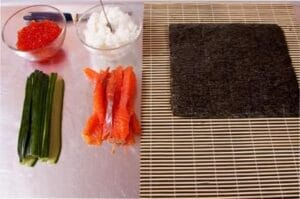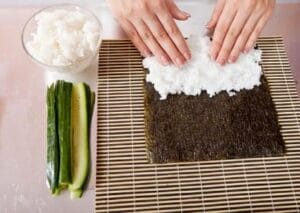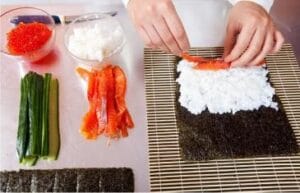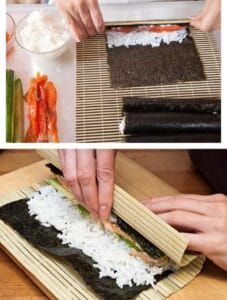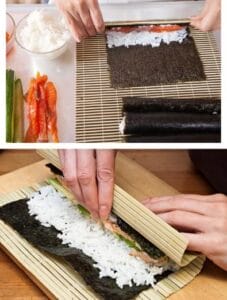Hello friends! My name is James Anderson and I’m so excited to share with you my new japanese recipe all about how to make sushi rolls at home. As someone who has a deep appreciation for Japanese cuisine and culture, learning how to prepare sushi has been high on my cooking bucket list for years.
After recently watching the documentary “Jiro Dreams of Sushi,” I was completely inspired by the dedication and artistry that goes into crafting perfect sushi. The way Jiro Ono has devoted his entire life to continuously improving his sushi skills really resonated with me. It made me want to challenge myself to learn this intricate cuisine and better understand the cultural importance behind it.
While I know it takes years of training to become an expert sushi chef, I figured trying my hand at some homemade sushi rolls would be a fun way to get my feet wet. I love hosting dinner parties for my friends and family, and being able to serve homemade sushi rolls as an appetizer sounds so impressive! Plus, it seems like a budget-friendly way to indulge in sushi more often.
In today’s article, I’ll be walking through everything you need to know how to make sushi rolls, nigiri, and more right from your own kitchen. I’ll share tips on selecting fresh fish and rice, easy rolling techniques, creative fillings ideas, and lots of troubleshooting advice from my trial and error attempts. Get ready to wow your dinner guests and understand why people become so obsessed with this iconic Japanese street food!
How to make sushi rolls


Sushi rolls recipe
Ingredients
- nori edible sheets of dried seaweed
- sushi rice
- raw fish and other seafood should always be sashimi-grade, meat, vegetables, fruit
- sushi condiments (there is a wide variety including soy sauce wasabi, pickled ginger, mayonnaise, Sriracha, and
Instructions
Prepare the nori sheet
- Line the rolling mat with a sheet of plastic wrap (this will help in shaping and storing the roll). Place one full sheet of sushi nori on the lined sushi rolling mat, shiny side down.

Spread with sushi rice
- Cover the nori sheet with prepared sushi rice, leaving the last inch and a half (away from you) bare. Use plastic gloves or moisten your hands with a solution of water and a little vinegar called tezu to prevent the rice from sticking (recipe below).

- NOTE: To make an inside-out roll, cover the rice layer with a sheet of plastic wrap. Lifting with the bottom plastic wrap, turn over the nori onto the bamboo rolling mat. Remove top plastic wrap.
Place the filling
- Place ingredients for the filling crosswise over the rice-covered nori.

Roll
- Fold the mat over, to roll the sushi. Apply firm pressure while rolling to make a tight roll.

Tighten the roll
- Moisten the flap of uncovered nori and roll over it to seal. Repeat rolling to tighten the roll, if necessary. Be careful not to roll the plastic wrap into the sushi.

Slice the roll
- Use a sharp, non-serrated knife and run cold water over the blade to keep the nori and rice from sticking. Do not use a sawing motion as this would tear the nori. To get even slices, begin slicing at the center of the roll then proceed to cut each piece at the center as well. Cut into 8 small pieces or 6larger pieces.

Video
Notes
Nutrition
© Food And Meal
This website provides approximate nutrition information for convenience and as a courtesy only. Nutrition data is gathered primarily from the Spoonacular Database, whenever available, or otherwise other online calculators.

Tips for making sushi

Cooking Tips
- Quality Ingredients: Invest in fresh, high-quality ingredients, especially your fish. Sashimi-grade fish is essential for a safe and delectable sushi experience.
- Perfectly Cooked Rice: The foundation of great homemade sushi rolls is perfectly cooked rice. Rinse it well and season with vinegar, sugar, and salt for that authentic flavor.
- Sharp Knife: Use a sharp, wet knife to slice your rolls. Wetting the blade prevents the rice from sticking and ensures clean cuts.
- Use a Bamboo Mat: When making rolled sushi, a bamboo sushi rolling mat is your best friend. It helps create tight, even rolls.
- Freshness Matters: Sushi rolls is best enjoyed fresh. Assemble your rolls just before serving to maintain their texture and taste.
- Wasabi and Soy Sauce: While it’s common to mix wasabi with soy sauce, purists suggest trying the homemade sushi rolls without soy sauce first to savor the chef’s intended flavors.
Serving Suggestions

- Serve sushi rolls and nigiri as appetizers or a light meal. They would pair nicely with miso soup, edamame, seaweed salad, or pickled ginger.
- For a heartier meal, consider making sushi bowls with rice, vegetables, protein like grilled teriyaki chicken or salmon, and sauce. Top with toasted sesame seeds.
- Try incorporating sushi ingredients like tuna, salmon, avocado, or cucumber into other dishes like salads, sandwiches, rice bowls, or pasta.
- Make sushi-stuffed peppers or squash for a fun twist. Fill halved peppers or baked squash with sushi rice and veggies or fish.
- For parties, set up a sushi station with prepared rolls, ingredients for custom maki rolls, and variety of dipping sauces like wasabi, soy sauce, ponzu, etc..
FAQ about Sushi

1. How to make sushi rolls step by step?
Answer: Follow these steps for making sushi at home:
- Prepare the nori sheet: Line a rolling mat with plastic wrap, place a sheet of sushi nori on it (shiny side down).
- Spread with sushi rice: Cover nori with prepared rice, leaving the last inch bare.
- Place the filling: Add ingredients crosswise over the rice.
- Roll: Fold the mat over, apply firm pressure, and roll tightly.
- Tighten the roll: Moisten the nori flap and roll over it to seal.
- Slice the roll: Use a sharp, non-serrated knife, and cut into 8 small or 6 larger pieces.
2. What makes the perfect sushi?
Answer: The perfect sushi involves several factors:
- High-quality, fresh ingredients, including sashimi-grade fish.
- Properly seasoned and textured sushi rice.
- Well-balanced fillings with a variety of flavors and textures.
- Skillful rolling and presentation.
- Attention to detail in slicing and serving.
3. How is sushi normally prepared?
Answer: Homemade Sushi rolls is typically prepared by:
- Crafting seasoned sushi rice.
- Arranging a sheet of nori on a rolling mat.
- Spreading rice on the nori and adding fillings.
- Rolling the sushi tightly using the mat.
- Cutting the roll into bite-sized pieces.
- Serving with soy sauce, wasabi, and pickled ginger.
4. How to prepare sushi safely at home?
Answer: Follow these safety tips when preparing sushi at home:
- Use sashimi-grade fish labeled for raw consumption.
- Keep utensils and hands clean.
- Wet hands before handling rice to prevent sticking.
- Store leftovers in the refrigerator, consuming them within 24 hours.
- Avoid raw fish if pregnant or with compromised immunity.
5. Can I prepare sushi rice in advance?
Answer: Yes, you can prepare sushi rice in advance and store it in a sealed container at room temperature for a few hours. Avoid refrigerating to maintain the rice’s texture.
6. How do I store leftover sushi?
Answer: Wrap leftover sushi tightly in plastic wrap and store it in the refrigerator. Consume within 24 hours for the best taste and quality.
7. What type of fish is suitable for sushi?
Answer: Sashimi-grade fish like tuna, salmon, and yellowtail are best for sushi. Ensure they are labeled as “sashimi-grade” for safety.
8. How do I prevent rice from sticking to my hands?
Answer: Keep a small bowl of water nearby and wet your hands before handling the rice. It prevents sticking and makes it easier to work with.
9. Can I customize my sushi fillings?
Answer: Absolutely! Sushi is highly customizable. Get creative with your fillings, from vegetables to cooked or raw fish, and tailor your sushi to your preferences.
Conclution
I hope you’ve enjoyed following along on my How to make sushi rolls guide. While it took some practice, I’m proud to now be able to craft homemade sushi that looks and tastes delicious. Making sushi has taught me to be more patient, precise, and appreciative of the artisanal craft that goes into Japanese cuisine, especially as I work on creating my own sushi recipe book.
Beyond gaining a new cooking skill, learning about sushi has allowed me to better understand and connect with Japanese culture. The care and attention to detail that goes into even the simplest sushi roll reflects meaningful values that I aim to apply in other areas of my life.
As I continue hosting sushi dinner parties for friends and experimenting with new fillings and styles in my kitchen, I’m excited to see where this new hobby takes me. I may never reach Jiro Ono status, but the lessons I’ve learned about dedication, continuous improvement, and appreciating life’s simple pleasures will stick with me.
Thank you for following my journey into sushi making. Please let me know in the comments if you try making your own rolls or have any requests for other Japanese recipes I should take on next! Itadakimasu!




